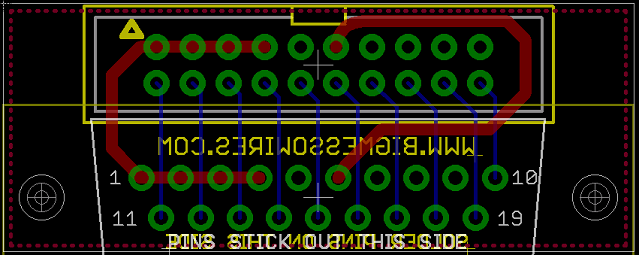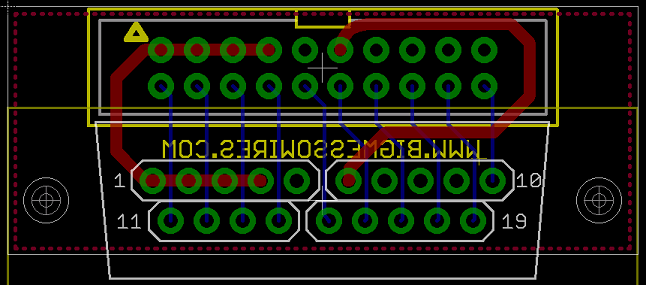Designing a DB-19 Substitute
I’m still searching for a source of more DB-19 connectors, but so far I’ve been unsuccessful finding a single one. As a backup plan, I’m exploring building a DB-19 substitute using a PCB and 19 individual pins. The result won’t really be a proper D-SUB connector, because it won’t have a surrounding shield, but it will still fit a DB-19 female port. Add a standard IDC-20 connector to the back side of the same PCB, and it can make a strange but effective DB-19 to IDC-20 converter cable.

The first version of this PCB is shown above, and is based on an idea by Charles Phillips. It uses four sections of standard 0.1 inch (2.54 mm) pitch male header. That’s the wrong pitch – a D-SUB connector has a 2.77 mm pitch – but it’s close enough that short sections of 4 or 5 header pins can bend a little and still fit the D-SUB. The advantage of this version is that it’s cheap and easy to make, and should be no trouble for the board assembly shop. Reliability is a question, though. Slightly bent pins may not make good contact inside the female port, or there may be an issue with square header pins in round port holes. But the initial tests look promising.

The second version of the PCB is very similar to the first, except the pads are all on a 2.77 mm pitch D-SUB grid instead of a 0.1 inch (2.54 mm) pitch. And instead of using 0.1 inch male header, it uses 19 individual D-SUB crimp pins in a non-standard way: the pins are each soldered in place, and then the crimp sections are cut off. The advantage of this version is that the pin spacing is perfect, and the pins are round, so the fit in the female port should be perfect. But it would be a couple of dollars more expensive, and it’s something that would have to be done manually, without standard assembly tools or processes. I need to check with the board assembly shop I’m using to see what effect it would have.
Neither of these PCBs has a shield surrounding the 19 pins, so if somebody tried hard enough, they could insert the connector aligned incorrectly. With the whole unit offset by 1 pin horizontally or vertically, the connected electronics might get zapped with 12 volts on a signal pin. You’d have to try pretty hard to do this, though.
Read 7 comments and join the conversation7 Comments so far
Leave a reply. For customer support issues, please use the Customer Support link instead of writing comments.



I like the header idea personally. I’m considering something similar for an Amiga video port (DB-23) project.
What about getting a db25 and sawing/milling off one end? The you still have the shield for most of the connector.
There are wire wrap pins that are meant to be inserted into holes in perf board to make individual pins. I would look into those.
I have seen these on eBay from a seller in Bulgaria, they make lots of custom cables, so they are still available I suspect. I did a quick search but couldn’t locate them, I think the name was Valerie or similar. I’ll keep looking and get back to you when i find them. They did ADTPro cables and floppy drive cables from memory. Stay tuned.
Martin..
Remove the sheath of a db-25 entirely and cut it down to size?
How about cutting off not the end of the DB25, but a slice out of the middle? Then the two end-pieces could be brought together (six pins shorter) and you’d have a connector with a shroud around both ends. Still not something that you’d want to do in large quantities, though.
The trouble with cutting down a DB25 is that it’s not something that can be automated, or even done consistently from one part to the next. Though I’ve never tried it, it sounds like a good solution if you’re building a one-off product for personal use. I’m using a PCB assembly service, and they do assembly with pick-and-place machines and reels of standardized components. I’m not sure they could handle an assembly step of “now take a DB25 and cut off about 1cm with a bandsaw”. If they could, it would likely raise the assembly cost substantially. But I’ll ask next time I talk with them – maybe I’m wrong.